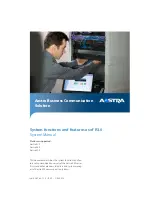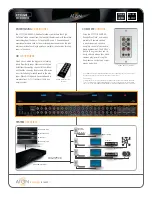
Chapter 4. Configuring RAID
This topic provides information about RAID and the utility programs that are available for you to configure
RAID.
Note:
After the storage array is identified by the server that it is connected to, refer to the documentation
that comes with the RAID card or HBA installed in the server to configure the storage array.
This topic contains the following items:
•
“About RAID” on page 27
•
“Configuring the advanced SATA/SAS hardware RAID” on page 28
About RAID
RAID, an acronym for Redundant Array of Independent Disks, is a technology that provides increased
storage functions and reliability through redundancy. This is achieved by combining multiple hard disk drives
into a logical unit, where data is distributed across the drives in one of several ways called RAID levels.
When a group of independent physical hard disk drives are set up to use RAID technology, they are in a
RAID array. This array distributes data across multiple hard disk drives, but the array appears to the host
server as one single storage unit. Creating and using RAID arrays provides high performance, such as the
expedited I/O performance, because several drives can be accessed simultaneously.
RAID drive groups also improve data storage reliability and fault tolerance compared with single-drive
storage systems. Data loss resulting from a drive failure can be prevented by reconstructing missing data
from the remaining drives.
The following list describes some of the most commonly used RAID levels:
•
RAID 0
: block-level striping without parity or mirroring
Simple stripe sets are normally referred to as RAID 0. RAID 0 uses striping to provide high data
throughput, especially for large files in an environment that does not require fault tolerance. RAID 0 has no
redundancy and it provides improved performance and additional storage without fault tolerance. Any
drive failure destroys the array and the likelihood of failure increases with more drives in the array. RAID
0 does not implement error checking, so any error is uncorrectable. More drives in the array means
higher bandwidth, but greater risk of data loss.
RAID 0 requires a minimum number of two hard disk drives.
•
RAID 1
: mirroring without parity or striping
RAID 1 uses mirroring so that data written to one drive is simultaneously written to another drive. This is
good for small databases or other applications that require small capacity but complete data redundancy.
RAID 1 provides fault tolerance from disk errors or failures and continues to operate as long as at least
one drive in the mirrored set is functioning. With appropriate operating system support, there can be
increased read performance and only a minimal write performance reduction.
RAID 1 requires a minimum number of two hard disk drives.
© Copyright Lenovo 2014
27
Содержание 70F0
Страница 1: ...ThinkServer Storage SA120 User Guide and Hardware Maintenance Manual Machine Types 70F0 and 70F1 ...
Страница 16: ...4 ThinkServer Storage SA120 User Guide and Hardware Maintenance Manual ...
Страница 35: ...Figure 17 Connecting two to four storage arrays to a server two rear I O modules Chapter 2 Product overview 23 ...
Страница 36: ...24 ThinkServer Storage SA120 User Guide and Hardware Maintenance Manual ...
Страница 38: ...26 ThinkServer Storage SA120 User Guide and Hardware Maintenance Manual ...
Страница 70: ...58 ThinkServer Storage SA120 User Guide and Hardware Maintenance Manual ...
Страница 74: ...62 ThinkServer Storage SA120 User Guide and Hardware Maintenance Manual ...
Страница 78: ...66 ThinkServer Storage SA120 User Guide and Hardware Maintenance Manual ...
Страница 95: ......
Страница 96: ......
















































